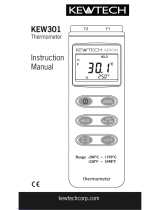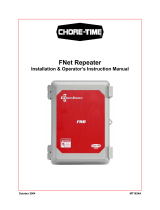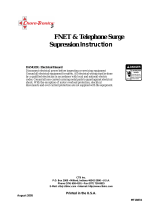
User’s Manual
LG Programmable Logic Controller
LG Industrial Systems
G3F-AD3A
G4F-AD3A
G6F-AD2A

Safety Precautions
Be sure to read carefully this safety precaution given in data sheet and user’s manual before
operating the module and follow them.
The precautions explained here only apply to the G3F-AD3A, G4F-AD3A, and G6F-AD2A.
For safety precautions on the PLC sys tem, please see the MASTER-K 200S/300S/1000S
User’s manual and the GLOFA GM3/4/6 User’s manual.
A precaution is given with a hazard alert triangular symbol to call your attention, and precautions
are represented as follows according to the degree of hazard.
However, a precaution followed with can also result in serious conditions.
Both of two symbols indicate that an important content is mentioned, therefore, be sure to
observe it.
Keep this manual handy for your quick reference in necessary.
If not provided with proper prevention, it can cause death
or fatal injury or considerable loss of property.
If not properly observed, it can cause a hazard situation
to result in severe or slight injury or a loss of property.
WARNING
CAUTION
CAUTION
Safety Precautions
Design Precautions
Do not run I/O signal lines near to high
voltage line or power line. Separate
them as 100mm or more as possible.
Otherwise, noi
se can cause module
malfunction.
CAUTION
Installation Precautions
Operate the PLC in the environment
conditions given in the general
specifications
If operation in other environment not
specified, it can cause an electric shock,
a fire, malfunction or damage or
degradation of the module.
Make sure the module fixing projections
is inserted into the module fixing hole
and fixed.
Improper installation of the module can
cause malfunction, disorder or falling.
CAUTION

Safety Precautions
Wiring Precautions
When grounding a FG termi
nal, be sure to provide class 3 grounding which is dedicated
to the PLC.
Before the PLC wiring, be sure to check the rated voltage and terminal arrangement for
the module and observe them correctly. If a different power, not of the rated voltage, is
applied or wrong wiring is provided, it can cause a fire or disorder of the module.
Fasten the terminal screws firmly to the defined torque. If loosely fasten, it can cause
short circuit, a fire or malfunction.
Be careful that any foreign matter like wire scraps
should not enter into the module. It can
cause a fire, disorder or malfunction.
CAUTION
Test Run and Maintenance Precautions
Do not contact the terminals while the
power is applied. It can cause
malfunction.
When cleaning or driving a terminal
screw, perform them after the power
has been turned off.
Do not perform works while the power
is applied, which can cause disorder
or malfunction.
CAUTION
Do not separate
the module from the
printed circuit board (PCB), or remodel
the module. Th
ey can cause disorder,
malfunction, damage of the module or a
fire.
When mounting or dismounting the
module, perform them after the power
has been turned off.
WARNING
Waste Disposal Precautions
When disposing the module, do it as an industrial waste.
CAUTION

CONTENTS
Chapter 1. INTRODUCTION
1.1 Features·································································································································································1-1
1.2 Terminology··························································································································································1-2
1.2.1 Analog Value : A ··················································································································································1-2
1.2.2 Digital Value : D···················································································································································1-2
1.3 Analog to Digital Conversion Characteristics ····················································································1-3
1.3.1 Voltage input························································································································································1-3
1.3.2 Current input························································································································································1-5
Chapter 2. SPECIFICATIONS
2.1 General Specifications ··································································································································2-1
2.2 Performance Specifications ·······················································································································2-2
2.3 Names of Parts and Functions ··················································································································2-4
2.3.1 G3F-AD3A ·························································································································································2-4
2.3.2 G4F-AD3A ·························································································································································2-5
2.3.3 G6F-AD2A ·························································································································································2-6
2.4 I/O Conversion Characteristics ·················································································································2-7
2.4.1 Voltage Input Characteristics ··························································································································2-8
2.4.2 Current Input Characteristics ··························································································································2-10
2.4.3 Simultaneous Voltage and Current Input Characteristics ················································································2-11
2.4.4 Analog input and Digital output characteristics ·······························································································2-12
2.5 Processing Specification······························································································································2-13
2.5.1 Sampling processing A/D conversion system···································································································2-13
2. 5.2 Averaging processing A/D conversion system ·································································································2-13
Chapter 3. INSTALLATION AND WIRING
3.1 Installation ··························································································································································3-1
3.1.1 Installation Ambience··········································································································································3-1
3.1.2 Handling Precautions ········································································································································3-1

3.2 Wiring ···································································································································································3-2
3.2.1 Wiring Precautions ············································································································································3-2
3.2.2 Wiring Examples ···············································································································································3-2
Chapter 4. FUNCTION BLOCK
4.1 Registration of the Function Block for the A/D Conversion Module on the GMWIN ·········4-1
4.2 Function Block for Local································································································································4-2
4.2.1 Module Initialization ···········································································································································4-2
4.2.2 Module Reading - Array Type ···························································································································4-4
4.2.3 Module Reading - Single Type····························································································································4-5
4.3 Remote Function Block ································································································································4-6
4.3.1 Module Initialization ···········································································································································4-6
4.3.2 Module Reading ··················································································································································4-8
4.4 Errors on Function Block ··························································································································4-10
Chapter 5. GM PROGRAMMING
5.1 Programming for Distinction of A/D Conversion Value····································································5-1
5.2 Programming for Display of A/D Conversion Value and Error Code on BCD Display...·····5-5
5.3 Programming for Loading the A/D Conversion Module on Remote I/O Station ··················5-8
Chapter 6. Buffer Memory
6.1 The configuration of buffer memory·········································································································6-1
6.1.1 G6F-AD2A···························································································································································6-1
6.1.2 G3F-AD3A / G4F-AD3A······································································································································6-2
6.2 The contents and description of buffer memory·················································································6-3
6. 2.1 G6F-AD2A···························································································································································6-3
6. 2.2 G3F-AD3A / G4F-AD3A······································································································································6-8
Chapter 7. Buffer read/write instructions
7.1 Buffer read instructions··································································································································7-1
7.1.1 GET/GETP instruction·········································································································································7-1
7.1.2 RGET instruction·················································································································································7-3
7.2 Buffer write instructuins·································································································································7-6
7.2.1 PUT/PUTP instruction·········································································································································7-6
7.2.2 RPUT instruction·················································································································································7-8

Chapter 8. MK Programming
8.1 Basic Programming ········································································································································8-1
8.1.1 G6F-AD2A ·························································································································································8-1
8.1.2 G3F-AD3A / G4F-AD3A ····································································································································8-2
8.2 Example Programming ·································································································································8-3
8.2.1 A program for comparision of A/D conversion value ························································································8-3
8.2.2 Output the analog input value by 7-segment display ·······················································································8-5
8.2.3 An A/D module mounted on a remote station·····································································································8-7
Chapter 9. DIMENSIONS
9.1 G3F-AD3A Dimensions ·································································································································9-1
9.2 G4F-AD3A Dimensions ·································································································································9-2
9.3 G6F-AD2A Dimensions ·································································································································9-3

Chapter 1 Introduction
1-1
1 Introduction
The G3F-AD3A, G4F-AD3A, and G6F-AD2A modules are analog-to -digital conversion
modules for use with the GLOFA PLC GM1/2/3/4/6 series and MASTER-K PLC
K200S/300S/1000S series. The G3F-AD3A is used with GM1/2/3 series and K1000S
series, G4F-AD3A is used with GM4 series and K300S series, and G6F-AD2A is used
with GM6 series and K200S series. (Hereafter the G3F-AD3A, G4F-AD3A, and G6F-
AD2A modules are called as the A/D conversion module)
The A/D conversion module is to convert an analog input sig nal (voltage or current) from
external devices into a 12-bit signed binary digital value.
1.1 Features
1) Multi-channel analog to digital conversion is possible with a single A/D module.
- G6F-AD2A : 4 channels
- G4F-AD3A and G3F-AD3A : 8 channels
2) The select of voltage input or current input is possible by channel of A/D module.
3) The unlimited number of A/D modules can be mounted on a base board.
The maximum number of A/D modules depends on the power capacity of power supply
module.( In case of use to the G6F-AD2A with G6F-DA2V and G6F-DA2I, it is depends
on the power capacity of the GM6-PAFB)

Chapter 1 Introduction
1-2
1.2 Terminology
1.2.1 Analog value : A
Analog value is a continuously changing value such as voltage, current, temperature,
speed pressure, flux, etc. Temperature, for example, is continuously changing according
to the time. Because this temperature itself is not available for input of the PLC, the
temperature should be converted an analog electrical signal by transducer. Moreover, the
converted analog signal (voltage or current) has to be converted into a digital value with
the A/D module because the PLC can handle only digital values.
Figure 1.1 Analog value
1.2.2 Digital value : D
Digital value is a discrete data that are described in numbers such as 0, 1, 2, … In
general, a binary code system that are consist of 0(off) and 1(on) is used for expressing
digital value. Also, BCD or hexadecimal values are used.
Because the CPU module of PLC can handle dig ital value only, the analog signal from
external devices should be converted into analog signals with A/D module.
In the other hand, the digital output of CPU module should be converted into analog
signal to be used for external devices. The D/A module (digital-analog converter) is used
for converting digital values into analog output (voltage or current).
Figure 1.2 Digital value
time
value
time
value

Chapter 1 Introduction
1-3
1.3 Analog-to-Digital conversion characteristics
1.3.1 Voltage input
The A/D module converts the analog input from external devices to the digital value that
can be handled by CPU module.
When the analog input is voltage input, the K4F-AD3A and K7F-AD3A has two input
ranges such as 1 ~ 5VDC and 0 ~ 10VDC. The K3F-AD2A has three input range such as
1 ~ 5VDC, 0 ~ 10VDC, and –10 ~ 10VDC.
With all analog input range, the digital output is varied in the range of 0 ~ 4000. Therefore,
the resolution of the A/D module is obtained by following equation;
1) 1 ~ 5VDC range
When the A/D module operates with 1 ~ 5VDC range, the 1VDC analog input is
converted to digital 0, and the 5VDC analog input is converted into digital output 4000.
Therefore, the resolution per 1 digital value is 0.001VDC.
Figure 1.3 A/D conversion characteristics ( 1 ~ 5VDC )
2000
2001
2002
1998
1999
3.000V
3.001V
2.999V
3.002V
2.998V
4000
2000
0
3V
5V
Analog input voltage
Digital output value
1V
4000
voltage inputMinimumvoltageinputMaximum
module A/DofResolution
−
=

Chapter 1 Introduction
1-4
2) 0 ~ 10VDC range
When the A/D module operates with 0 ~ 10VDC range, the 0VDC analog input is
converted to digital 0, and the 10VDC analog input is converted into digital output 4000.
Therefore, the resolution per 1 digital value is 0.0025VDC.
Figure 1.4 A/D conversion characteristic ( 0 ~ 10VDC )
3) –10 ~ 10VDC range
When the A/D module operates with –10 ~ 10VDC range, the 10VDC analog input is
converted to digital 0, and the 10VDC analog input is converted into digital output 4000.
Therefore, the resolution per 1 digital value is 0.005VDC.
Figure 1.5 A/D conversion characteristic ( -10 ~ 10VDC )
2000
2001
2002
1998
1999
5.000V
5.0025V4.9975V
5.005V
4.995V
4000
2000
0
5V
10V
Analog input voltage
Digital output value
0V
2000
2001
2002
1998
1999
0.000V
0.005V
-0.005V
0.010V
-0.010V
4000
2000
0
0V
10V
Analog input voltage
Digital output value
-10V

Chapter 1 Introduction
1-5
1.3.2 Current input
When the analog input is current input, the A/D conversion module has only one input
ranges such as 4 ~ 20mA.
With all analog input range, the digital output is varied in the range of 0 ~ 4000. Therefo re,
the resolution of the A/D module is obtained by following equation;
1) 4 ~ 20mA range
When the A/D module operates with 4 ~ 20mA range, the 4mA analog input is converted
to digital 0, and the 20mA analog input is converted into digital output 4000. Therefore,
the resolution per 1 digital value is 0.004mA.
Figure 1.6 A/D conversion characteristic ( 4 ~ 20mA )
4000
currentinputMinimumcurrentinputMaximum
moduleA/DofResolution
−
=
2000
2001
2002
1998
1999
12.000mA
12.004mA
11.996mA
12.008mA
11.992mA
4000
2000
0
12mA 20mA
Analog input current
Digital output value
4mA

Chapter 2. SPECIFICATIONS
2 - 1
Chapter 2 . SPECIFICATIONS
Table 2.1 shows the general specifications of GLOFA GM series and MASTER-K series.
Item Specifications Standard
Operating ambient
temperature
0 ~ 55
Storage ambient
temperature
-25 ~ 70
Operating ambient
humidity
5 ~ 95%RH, non-condensing
Storage ambient
Humidity
5 ~ 95%RH, non-condensing
In case of occasional vibration Sweep count
Frequency Acceleration Amplitude
10 f 57 Hz
- 0.075 mm
57 f 150 Hz
9.8 (1G)
-
In case of continuos vibration
Frequency Acceleration Amplitude
10 f 57 Hz
- 0.035 mm
Vibration
57 f 150 Hz
4.9 (0.5G)
-
10 times in each
direction for
X, Y, Z
IEC 61131-2
Shocks
*Maximum shock acceleration: 147 {15G}
*Duration time :11 ms
*Pulse wave: half sine wave pulse( 3 times in each of X, Y and Z directions )
IEC 61131-2
Square wave impulse noise 1,500 V
LGIS
Standard
Electrostatic discharge Voltage :4kV(contact discharge)
IEC 61131-2
IEC1000-4-2
Radiated electromagnetic field 27 ~ 500 MHz, 10 V/m
IEC 61131-2
IEC1000-4-3
Modules
All power
modules
Digital I/Os
( Ue≥ 24 V)
Digital I/Os
(Ue < 24 V)
Analog I/Os
communication
I/Os
Noise immunity
Fast transient
&
burst noise
Voltage 2 kV 1 kV 0.25 kV
IEC 61131-2
IEC1000-4-4
Operating atmosphere Free from corrosive gases and excessive dust
Altitude for use Up to 2,000m
Pollution degree 2 or lower
Cooling method Self-cooling
[Table 2.1 ] General specifications
REMARK
1) IEC(International Electrotechnical Commission)
: The international civilian organization which produces standards for electrical and electronics industry.
2) Pollution degree
: It indicates a standard of operating ambient pollution level.
The pollution degree 2 means the condition in which normally, only non-conductive pollution occurs.
Occasionally, however, a temporary conductivity caused by condensation shall be expected.
2.1 General Specifications

Chapter 2. SPECIFICATIONS
2 - 2
Table 2-2 shows performance specifications of A/D conversion module.
1) G3F-AD3A, G4F-AD3A
Specifications
Items
G3F-AD3A G4F-AD3A
I/O points 16 points
Voltage
1 ~ 5 VDC (input resistance 600 )
0 ~ 10 VDC (input resistance 600 )
Current
DC 4 ~ 20 mA (input resistance 250 )
Analog
input
Voltage/Current selection
- Adjust input selection switch for each channel on side of module.
( ON : Current, OFF : Voltage)
- Selection of voltage range by program
Digital output - 16 bit binary value
1 ~ 5VDC 1 mV (1/4000)
0 ~ 10VDC 2.5 mV (1/4000)
Maximum
resolution
DC 4 ~20mA
4 (1/4000)
Overall Accuracy
0.5% (accuracy to full scale)
Max . conversion speed 5.0 ms/channel
Max . absolute input Voltage : 15V, Current : 25mA
Number of analog input point 8 channels/module
Isolation
Between input terminals and PLC: Photo coupler isolation
(Between channels : Non-isolated)
Terminals connected 20-point terminal block
Internal current consumption 0.5 A 0.5 A
Weight 310 280
[Table 2.2] Performance Specifications
CAUTION
The manufacturer set value of A/D conversion module has been current input mode.
2.2 Performance Specifications
!

Chapter 2. SPECIFICATIONS
2 - 3
2) G6F-AD2A
Items Specifications
I/O points 16 points
Voltage
1 ~ 5 VDC (input resistance 1 )
0 ~ 10 VDC (input resistance 1 )
-10 ~ 10VDC (input resistance 1 )
Current
DC4 ~ 20 mA (input resistance 250 )
Analog
input
Voltage/Current selection
- Selection with Terminal
( It has to be connected between V and I terminal to select current. )
- Selection of voltage range by switch on the side of module
Digital output
- 12 bit binary value(-48 ~ 4047, -2048 ~ 2047)
-
Digital output value is selected by program.
1 ~ 5VDC 1 mV (1/4000)
0 ~ 10VDC 2.5 mV (1/4000)
-10 ~10VDC 5 mV (1/4000)
Maximum
resolution
DC 4 ~20mA
4 (1/4000)
Overall Accuracy
0.5% (accuracy to full scale)
Max . conversion speed 5.0 ms/channel
Max . absolute input Voltage : 15V, Current : 25mA
Number of analog input point 4 channels/module
Isolation
Between input terminals and PLC: Photo coupler isolation
(Between channels : Non-isolated)
Terminals connected 18-point terminal block
+5VDC
40mA
+15VDC
50mA
Current
Consumption
-15VDC
20mA
Weight
200g
[Table 2.2] Performance Specifications
CAUTION
The factory-set value of A/D conversion module has been current input mode.
The G6F-AD2A has to be used with the GM6-PAFB.
!

Chapter 2. SPECIFICATIONS
2 - 4
The names of parts and functions of the A/D conversion module are shown as below.
2.3.1 G3F-AD3A
2.3 Names of Parts and Functions

Chapter 2. SPECIFICATIONS
2 - 5
2.3.2 G4F-AD3A
No Description
←
RUN LED
Indicates the operating status of the G3F-AD3A and G4F-AD3A.
↑
Selection switch of voltage/current
1)The switch status at voltage selection
The switch locates off status.
2)The switch statues at current selection
The switch locates on status
On
1 2 3 4 5 6 7 8
On
1 2 3 4 5 6 7 8

Chapter 2. SPECIFICATIONS
2 - 6
2.3.3 G6F-AD2A
No Description
←
RUN LED
Indicates the operating status of the G6F-AD2A.
↑
Selection switch of voltage/current
Analog Input Input Range Selection Switch
DC 1~5V
DC 0~10V
Voltage
DC-10~10V
Current DC 4~20mA
1
2
3
J1
J2
1 2 3
J1
J2
1
2 3
J1
J2
1
2
3
J1
J2

Chapter 2. SPECIFICATIONS
2 - 7
Input / Output (hereafter I/O) conversion characteristics are expressed with the angle of the line between
analog input(voltage and current) and matched digital value.
I/O conversion characteristics of the G3F-AD3A, G4F-AD3A are expressed with Fig 2.1, and I/O conversion
characteristics of the G6F-AD2A is expressed with Fig 2.2
The voltage or current input for a channel is selected by analog input selection switch and the value of
Offset / Gain can not be changed because it is fixed.
[Fig 2.1] I/O Conversion Characteristics
REMARK
1. The analog output value of over 4047 or –48 is fixed as 4047 or –48.
2. Keep the input voltage and current not to exceed +15V and 25mA.
2.4 I/O Conversion Characteristics
Practical analog input range
Digital
Output
Value
4000
3000
2000
1000
0
0V
5V
10V
1V
3V
5V
4 12 20
DC 0 ~ 10V
DC 1 ~ 5V
DC 4 ~ 20
Analog
Input
-0.12V
3.808
0.952V
10.12V
20.192
5.048V
4047
-48

Chapter 2. SPECIFICATIONS
2 - 8
[Fig 2.1] I/O Conversion Characteristics
REMARK
1. The analog output value of over 4047 or –48(2047 or –2048) is fixed as 4047 or –48(2047 or –2048).
2. Keep the input voltage and current not to exceed +15V and 25mA.
2.4.1 Voltage Input Characteristics
1) G3F-AD3A, G4F-AD3A
For voltage input, the corresponding input selection switch of each channel should be set to "off".
–
The voltage input range is selected in program.
Input selection switch has to be located at off.
(1)Voltage input range : DC 0 10V
Digital output value for input voltage is shown as follows.
Analog input voltage (V)
-0.12 0 2.5 5 7.5 10 10.12
Digital output value -48 0 1000 2000 3000 4000 4047
Input selection switch
- Off : Voltage
(This switch is located
on the side of module)
On
1 2 3 4 5 6 7 8
CH0 1234567 Number of channel
Practical analog input range
Digital
Output
Value
4000
3000
2000
1000
0
0V
5V
10V
1V
3V
5V
-10V
0V 10V
DC 0 ~ 10V
DC 1 ~ 5V
DC-10 ~ 10V
Analog
Input
-0.12V
-10.24V
0.952V
10.12V
10.24V
5.048V
4047
-
48
4 12 20DC 4 ~ 20
3.808
20.192
2000
1000
0
-1000
-2000
2047
-2048

Chapter 2. SPECIFICATIONS
2 - 9
(2)Voltage input range : DC 1 5V
Digital output value for input voltage is shown as follows.
Analog input voltage (V)
0.952 1 2 3 4 5 5.048
Digital output value -48 0 1000 2000 3000 4000 4047
2) G6F-AD2A
For voltage input, the corresponding input is selected by selection switch and selected input voltage range is
same through whole channels.
1) Voltage input range
: DC 1 V
Digital output value for input voltage is shown as follows.
Analog input voltage (V)
Input range selection
switch
0.952 1 2 3 4 5 5.048
-48 0 1000 2000 3000 4000 4047
Digital output value
-2048 -2000 -1000 0 1000 2000 2047
2)
Voltage input range :
DC 0 V
Digital output value for input voltage is shown as follows.
Analog input voltage (V)
Input range selection
switch
-0.12 0 2.5 5 7.5 10 10.12
-48 0 1000 2000 3000 4000 4047
Digital output value
-2048 -2000 -1000 0 1000 2000 2047
3)
Voltage input range :
DC -10 V
Digital output value for input voltage is shown as follows.
Analog input voltage (V)
Input range selection
switch
-10.24 -10 -5 0 5 10 10.24
-48 0 1000 2000 3000 4000 4047
Digital output value
-2048 -2000 -1000 0 1000 2000 2047
1 2
3
11
12
1 2
3
J1
J2
1
2
3
11
12
1
2
3
J1
J2
1
2
3
J1
J2
Page is loading ...
Page is loading ...
Page is loading ...
Page is loading ...
Page is loading ...
Page is loading ...
Page is loading ...
Page is loading ...
Page is loading ...
Page is loading ...
Page is loading ...
Page is loading ...
Page is loading ...
Page is loading ...
Page is loading ...
Page is loading ...
Page is loading ...
Page is loading ...
Page is loading ...
Page is loading ...
Page is loading ...
Page is loading ...
Page is loading ...
Page is loading ...
Page is loading ...
Page is loading ...
Page is loading ...
Page is loading ...
Page is loading ...
Page is loading ...
Page is loading ...
Page is loading ...
Page is loading ...
Page is loading ...
Page is loading ...
Page is loading ...
Page is loading ...
Page is loading ...
Page is loading ...
Page is loading ...
Page is loading ...
Page is loading ...
Page is loading ...
Page is loading ...
Page is loading ...
Page is loading ...
Page is loading ...
Page is loading ...
Page is loading ...
Page is loading ...
Page is loading ...
Page is loading ...
Page is loading ...
Page is loading ...
Page is loading ...
Page is loading ...
Page is loading ...
Page is loading ...
-
 1
1
-
 2
2
-
 3
3
-
 4
4
-
 5
5
-
 6
6
-
 7
7
-
 8
8
-
 9
9
-
 10
10
-
 11
11
-
 12
12
-
 13
13
-
 14
14
-
 15
15
-
 16
16
-
 17
17
-
 18
18
-
 19
19
-
 20
20
-
 21
21
-
 22
22
-
 23
23
-
 24
24
-
 25
25
-
 26
26
-
 27
27
-
 28
28
-
 29
29
-
 30
30
-
 31
31
-
 32
32
-
 33
33
-
 34
34
-
 35
35
-
 36
36
-
 37
37
-
 38
38
-
 39
39
-
 40
40
-
 41
41
-
 42
42
-
 43
43
-
 44
44
-
 45
45
-
 46
46
-
 47
47
-
 48
48
-
 49
49
-
 50
50
-
 51
51
-
 52
52
-
 53
53
-
 54
54
-
 55
55
-
 56
56
-
 57
57
-
 58
58
-
 59
59
-
 60
60
-
 61
61
-
 62
62
-
 63
63
-
 64
64
-
 65
65
-
 66
66
-
 67
67
-
 68
68
-
 69
69
-
 70
70
-
 71
71
-
 72
72
-
 73
73
-
 74
74
-
 75
75
-
 76
76
-
 77
77
-
 78
78
LG G4F-AD3A User manual
- Category
- Water pumps
- Type
- User manual
Ask a question and I''ll find the answer in the document
Finding information in a document is now easier with AI
Other documents
-
 Perfect Prime TC0301 Datalogger Thermometer User manual
Perfect Prime TC0301 Datalogger Thermometer User manual
-
Moxa NDR Power Supply Series Quick setup guide
-
 Kewtech KEW301 User manual
Kewtech KEW301 User manual
-
 Chore-Time MT1824A CHORE-TRONICS® FNet Repeater Installation and Operators Instruction Manual
Chore-Time MT1824A CHORE-TRONICS® FNet Repeater Installation and Operators Instruction Manual
-
Sunricher SR-1009(0-10V/PWM) User manual
-
 Chore-Time MT1887A CHORE-TRONICS® 2 FNet & Telephone Surge Suppression Operating instructions
Chore-Time MT1887A CHORE-TRONICS® 2 FNet & Telephone Surge Suppression Operating instructions
-
Airwell Monobloc R32 Operating instructions
-
HANYOUNG NUX Connector relay cable Owner's manual
-
Delta Electronics DVP06AD-S User manual
-
Mitsubishi Electric 1786FD2 User manual

















































































